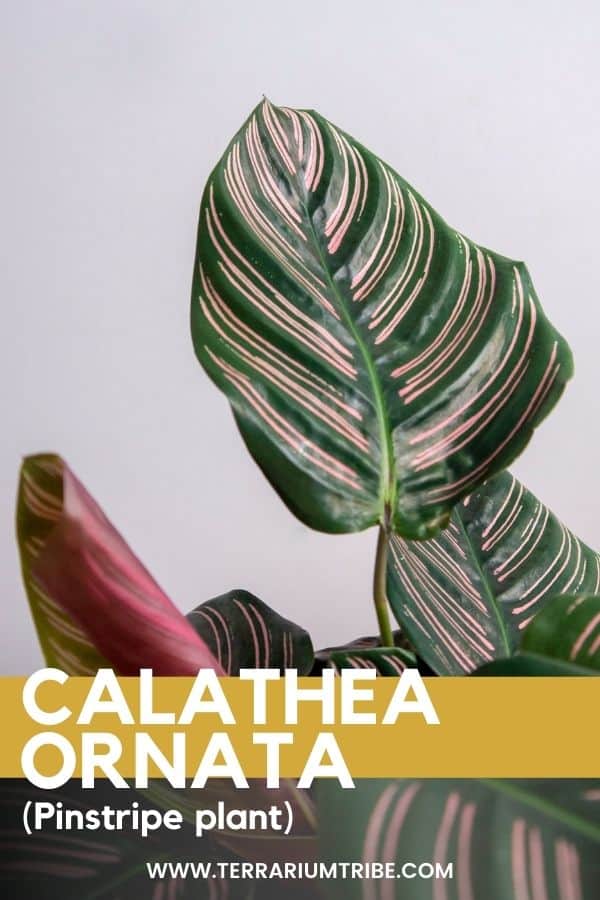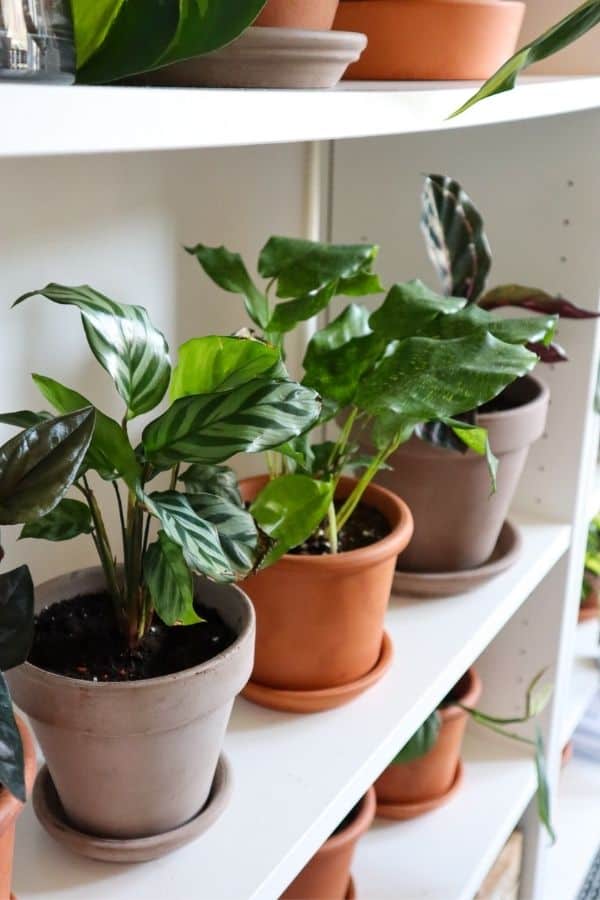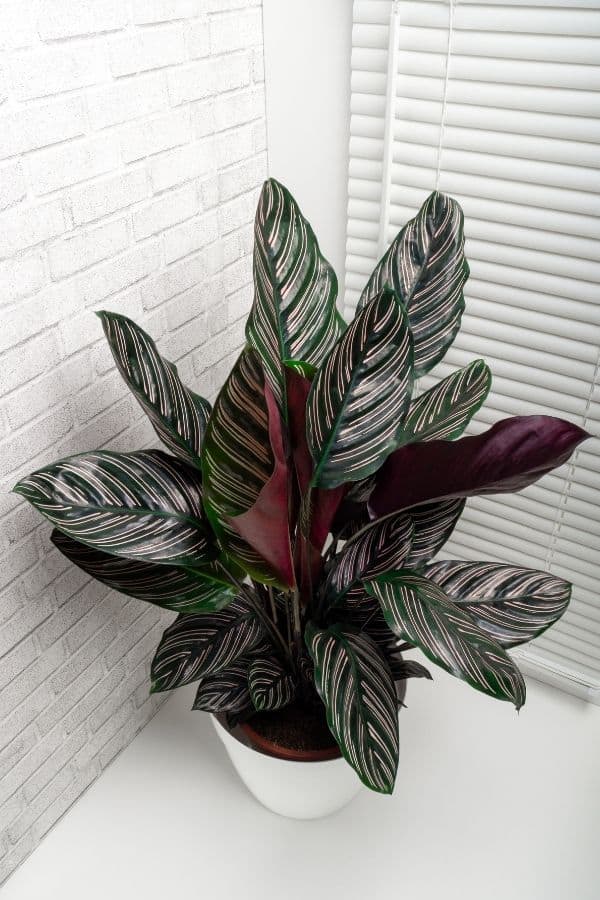Pink plants are in, haven’t you heard? Well, now it’s pinstripes too.
Okay, the Calathea ornata is mostly dark emerald green, but that only serves to make those gorgeous pink pinstripes (and purple leaf undersides) pop!
She really is a beauty, but she’s a bit of a diva too.
As with all Calathea, there’s an extra level of care and attention required to keep the Pinstripe Plant happy, healthy, and drama-free.
That being said, it absolutely can be done. Personally, I’ve grown a variety of prayer plants in the home with little to no issues, and in this guide, I’ll show you how.

What is Calathea ornata? & How Does it Earn its (Pin)stripes?
Originally from the jungles of Peru, Brazil, and Colombia (amongst other places in South America), the Pinstripe Plant is a tropical foliage plant that looks straight out of a Renaissance painting.
A gorgeous contrast of rich and vibrant colors.
It’s part of the prayer plant family, meaning its foliage not only looks dramatic, but it’ll also act it, too. The leaves open through the day and close at night into a “prayer hands” position – cool, right?
With a compact – and later upright – growth pattern, Calathea ornata makes a beautiful addition to a terrarium focal center or shady room corner.
Okay, next, we get into care requirements.
Where to Buy Calathea Pinstripe
See the links below to purchase from reputable terrarium plant shops and marketplaces (may include affiliate links).
Calathea ornata Care & Growth
At a Glance
| Plant Type | Foliage |
| Lighting | Bright, indirect light |
| Temperature | 65-85°F (18-29°C) |
| Watering | Moderate to high, even moisture |
| Humidity | Medium to high (50-80%) |
| Growth | 12-24 inches |
Lighting
Being a pretty compact plant living on the rainforest floor, Calathea ornata plants are accustomed to receiving pretty minimal sunlight in the wild.
Only dappled light that’s reached through the canopy all the way to the bottom.
So, in the home you can expect your Calathea to do pretty well in the shadier spots in your home.
However, if you really want to get the brightest pink stripes and healthiest plants, you’ll have to do better than partial darkness, I’m afraid.
Bright indirect light is your best bet here.
North-facing windows offer a good solution for a thorough day of indirect sunlight without the risk of any direct sunlight at all.
The thing is, direct light is a risk for many plants, but the damage is almost a given with the delicate foliage of these plants.
I keep my Calathea in a room with a South-facing window, but they’re on a bookshelf that’s several meters into the room, far away from any direct sunbeams.

We’ve even kept them right at the back of the room where nothing would grow, and my Calathea has continued to go from strength to strength.
If in doubt, I’d start in the shadiest spot and then move to progressively brighter spots. Even a day of harsh sunlight can ruin your plant.
Watering
Just as they would in their native tropical environments, Calathea prefers to grow in consistently moist soil/substrate.
After all, water is not a scarce commodity on the rainforest floor, so you should be supplying your indoor plant with plenty of moisture to recreate that at home.
On the flip side, that high moisture level is always balanced by great drainage.
We can’t be dropping monsoon levels of water into our plants on a regular basis if there’s nowhere for the excess to go, right?
The first step is always to have a drainage hole in your plant pot.
Seriously, it’s a must on this one.
That way, you can thoroughly water your plant each time without the risk of waterlogging your substrate.
Root rot is a genuine concern with Calathea ornata, so getting this right is perhaps the most important thing when it comes to taming this temperamental creature.
Terrariums have their advantages and disadvantages here, as getting the right water balance can be harder to achieve, but the closed nature of the system makes it much easier to maintain consistent moisture.
Oh, and one last thing: Calathea, on the whole, are reportedly pretty sensitive to fluoridated water. I’ve never had any issues with tap water, but the water is pretty “soft” in my area.
Crispy leaf edges can supposedly be a sign of chemical damage, so you might want to switch to rainwater and other purified options if you see this happening. Otherwise, for terrariums, you should really be using purified water anyway.
Substrate
The Pinstripe Calathea loves a water-retentive but well-draining substrate blend.
I’d recommend a coco coir base with earthworm castings for natural fertilizer and additional supplementary material to increase drainage and water retention.
Perlite and pumice are both good options to add, though I actually think vermiculite may be an even better option here as it holds the highest level of moisture (not to mention it looks a lot better, in my opinion).
Orchid bark would work, too, but Calathea don’t need a chunky mix like Aroids do.
In a terrarium, I’d add some preserved sphagnum moss to the mix instead to really maximize water retention and encourage healthy roots.
Temperature & Humidity
Maintaining a consistently high humidity level is a dealbreaker for this notoriously finicky tropical plant.
You don’t need to be pushing sweltering rainforest levels, but you do need to be hitting 50%+ if you want to see these Calathea thrive.
Pebble trays and humidifiers can be useful if you live in a dry environment, or you can always put them in a closed terrarium and solve all your problems.
Not that I’m biased or anything…
Temperature is key, too. These tropical plants like to stay within an average room temperature range, rarely dropping below 60°F (15°C) and far from drafts and heat vents.
They’re not frost-hardy by any means (so take extra care in the colder months), but you also need to be careful of them drying out if you live in exceptionally hot areas.
Did I mention Calathea ornata is temperamental?
Growth
This plant grows in an upright fashion and isn’t known as a particularly fast grower.
Once it reaches a size of roughly two feet wide and two feet tall (60cm x 60cm), the Pinstripe Plant starts to reach full maturity and tends to slow its growth.
But it’s going to take a long time to get there.

Once this happens, you can either prune and maintain it as is or separate the plant into multiple, smaller plants and continue down the path of turning your home into a Calathea sanctuary – but that’s based on personal preference.
You can add additional houseplant fertilizer in the growing season, but I find it’s rarely necessary (especially if you’re using worm castings in the substrate).
Propagation
There’s really only one method to propagate Calathea in the home, and that’s through division.
To do this, you should give the plant enough time to mature and grow dense in its pot. When it’s looking like it needs a bigger pot, that’s usually a convenient time to do it.
Taking the entire plant out, gently divide its root structure into smaller portions and replant each in its own container. It’s as simple as that.
Over time, these new plants will fill out and look just as lush as they did before!
If you find your Pinstripe plant is outgrowing your terrarium, this is a good way of keeping it in check without hacking it down.
Varieties & Similar Plants
The Calathea genus is filled with hundreds of varieties, some naturally occurring, and some cultivated a bred from two or more species within this group.
The Pinstripe Plant, in particular, can be found with either pink or white-ish green stripes across its dark green leaves. Though this difference in color depends upon the age of the plant and not necessarily the species.
Other Calathea of note (all of which I have in my collection) are the gorgeous Peacock Plant (Calathea makoyana), Calathea orbifolia, Calathea roseopicta, and Calathea musaica.
Not to mention others in the Marantaceae family, including the Fishbone Prayer Plant (Ctenanthe burle-marxii).
Frequently Asked Questions
You should water Calathea ornata when the top of the soil/substrate is dry to the touch. Though, you should never let it fully dry out.
Calathea ornata is a versatile plant, happy to live indoors, in closed terrariums, and outdoors if you live in a suitably tropical climate.
Curling leaves can be a sign that your Calathea ornata needs more moisture or a higher humidity level.
Calathea ornata doesn’t grow particularly fast. Plus, they often sacrifice leaves to push out new ones, which makes overall growth a slow process.
Calathea ornata can be prone to both fungus gnats and spider mites.
